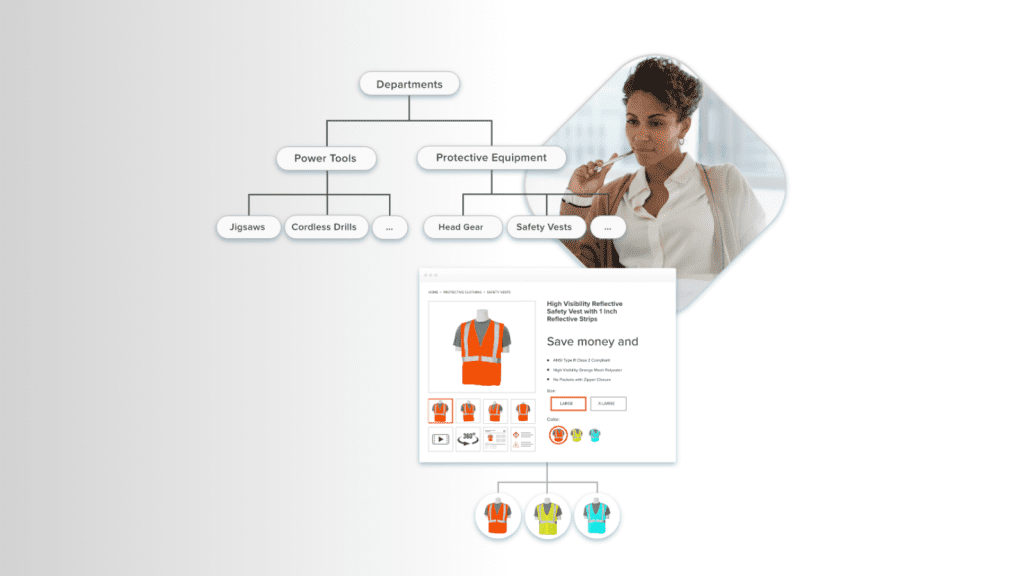Simplifying Shopify Product Variants: Manage Complex Configurations

- Shopify's Variants feature is flexible but insufficient for complex products with multiple configurations.
- Strategies like splitting products, using third-party apps, and leveraging metafields can help manage complex configurations within Shopify.
- A unified PIM and DAM solution offers the most comprehensive approach for managing sophisticated product data and digital assets in Shopify.
In this Article
Managing product listings on Shopify can be straightforward—until you’re dealing with products in multiple configurations. Suddenly, what should be a simple task turns into a logistical nightmare. How do you ensure that every possible variant is represented without overwhelming your customers or slowing down your store?
The challenge is even more significant for business-to-business (B2B) marketers. You’re not just listing products; you’re catering to professional buyers who need precise information on each variant. However, while powerful, Shopify’s product variants feature isn’t always intuitive when your catalog includes complex configurations.
So, how do you navigate this without losing your sanity—or worse, potential sales? This guide walks you through practical strategies to simplify Shopify product variants, helping you efficiently manage even the most complex configurations. Most crucially, you’ll learn that tools like PIM and DAM software are handy solutions for effectively managing product variant SKUs, product information, and digital assets.

What Is the Variants Feature in Shopify?
A Shopify variant is a distinct product configuration within a single product listing, defined by specific combinations of product options. These options can include size, color, material, voltage, power, or any other attribute that differentiates one product version from another.
For example, a drill product might have options for voltage (12V, 18V), battery type (lithium-ion, nickel-cadmium), and chuck size (½ inch, ¾ inch). Each unique combination of these options represents a different variant.
In other words, a Shopify variant is simply a version of a product with specific attributes. Think of it as a way to offer customers choices without creating entirely new product listings.
Shopify allows up to 100 variants per product, with each variant potentially having up to three option types (size, color, and material). This system works well for many products but can quickly become complex when dealing with industrial or highly customizable items.
The Challenges of Complex Configurations
A complex configuration may mean many things depending on one’s situation. As such, we will use an example to illustrate this concept within the context of this discussion.
An example of a complex product configuration
Suppose you are a marketer, and your company manufactures custom industrial machinery. The company’s flagship product is a multi-functional machine used in manufacturing plants, and it’s available in several customizable configurations to meet the specific needs of different industries.
When listing this product on Shopify, you need to account for the following options:
- Motor type: Electric, hydraulic, or pneumatic.
- Material: Steel, aluminum, or titanium.
- Finish: Matte, glossy, or textured.
- Control system: Manual, semi-automated, or fully automated.
- Additional features: Built-in sensors, safety enclosures, and customizable interfaces.
Each of these options can be mixed and matched, leading to hundreds, if not thousands, of possible combinations. For instance, one customer might need a steel machine with a hydraulic motor, a glossy finish, and a fully automated control system. Another might prefer an aluminum machine with an electric motor, a matte finish, and semi-automated controls but with the added safety enclosure.
This level of customization is fantastic for meeting your clients’ specific needs, but when it comes to setting up your Shopify store, the sheer number of potential variants can become overwhelming. Not only do you need to ensure that each possible configuration is accurately represented, but you also have to manage the associated SKUs, pricing, and inventory for each variant.
As you add more customization options, the complexity increases exponentially, putting immense pressure on Shopify’s product variant feature. Suddenly, what seemed like a manageable product listing turns into a jumble of options that can be difficult to navigate for both you and your customers.
Variant limitations
One thing immediately jumps out when examining the example above: Shopify’s limitations on the Variants feature complicate listings for companies with complex products. Here’s how:
1. The three-option rule and 100-variant cap
We noted earlier that Shopify limits each product to only three options and a maximum of one hundred unique variants. This is a massive bottleneck when dealing with a highly customizable product like industrial machinery.
For instance, in the scenario highlighted in the illustration, the machinery offers options for motor type, material, finish, control system, and additional features. Even if the marketer narrows it down to the three most critical options—say, motor type, material, and finish—they could still end up with many combinations. The total number of variants for a single product can quickly exceed Shopify’s 100-variant cap, especially considering all the possible configurations.
What happens when they exceed these limits? The marketer must simplify their offerings—potentially losing customers who need those specific configurations—or create multiple product listings, which can confuse buyers and make the store harder to navigate.
2. Inventory management and pricing complexities
With potentially thousands of configurations, tracking inventory becomes an uphill task. Each unique combination might require different components or assembly processes, making it challenging to:
- Accurately represent available stock for each variant
- Forecast demand and manage the supply chain for numerous possible configurations.
- Update inventory levels efficiently when components are shared across multiple variants.
Pricing is another area where these limitations come into play. If each variant has a different cost—say, a titanium finish costs more than a steel one or a fully automated control system adds a premium—managing these price variations within Shopify’s system can be difficult. The platform’s pricing model for variants may not offer the flexibility you need, forcing you to find workarounds or, again, simplify your offerings in ways that don’t best serve your customers.
3. Maintaining a clear, user-friendly product page
Presenting too many product options on a single product page can overwhelm customers. The information overload that results from a cluttered product page creates several challenges, including:
- Customers may struggle to navigate through numerous dropdown menus or option selectors.
- It becomes difficult to clearly communicate how different options impact the final product’s functionality, appearance, or price.
- Providing visual representations for each possible configuration is nearly impossible within the standard Shopify interface.
In the scenario detailed in the illustration, customers might struggle to select the right combination of features, especially if the differences between options aren’t immediately apparent. This complicates their buying journey and could increase the likelihood of returns or customer dissatisfaction if they mistakenly order the wrong configuration.

Managing Complex Configurations Effectively
Despite the challenges, merchants have options when dealing with complex product configurations. With the right strategies and tools, they can work around these challenges to optimize their stores, provide a seamless shopping experience, and ultimately increase sales. Let’s see some strategies and tools merchants can deploy.
1. Optimizing within Shopify's variant limits
The upside is merchants can wiggle under Shopify’s variant limits to create an optimized listing. For example, the marketer in the earlier illustration can leverage the following strategies.
- Identify and prioritize core options: Determine the most critical product attributes significantly impacting price, functionality, or customer preference. Prioritize these options to be included as Shopify variants. For less impactful attributes, consider grouping similar options or creating descriptive variant titles to accommodate multiple characteristics within a single variant.
- Split products into separate listings: Instead of cramming all options into one product, consider creating multiple listings. For the industrial machinery example, the marketer could have individual listings for each motor type (electric, hydraulic, pneumatic). This approach allows them to use the remaining options for other features, staying within the 3-option limit. Alternatively, they can create multiple parent products based on critical differentiators (e.g., product type, size range). They can then utilize internal linking to connect related products to provide a seamless customer experience while managing variant complexity.
- Bundle options strategically: Combine related options to reduce the total number of variants. For instance, the marketer could create a “Performance Package” that includes specific combinations of motor type and control system. This not only reduces variants but can also simplify customers’ decision-making. Alternatively, they can provide opportunities for customers to customize products further during the checkout process, allowing for greater flexibility without overwhelming the product page.
- Use line-item properties: For less critical options that don’t affect pricing or inventory, utilize Shopify’s line-item properties. These allow customers to add notes to their orders, which merchants can use for customization details that don’t require separate variants.
- Leverage product metafields: Shopify’s metafields feature can store additional product information without creating new variants. In the case of the company in the illustration, metafields can be particularly useful for handling detailed specifications and options that customers need to know but don’t necessarily choose between.
For example, the company could use metafields to store:
- Technical specifications: Power consumption rates for different motor types, maximum load capacities for various materials, or operating temperature ranges.
- Compatibility information: Which additional features work with specific configurations?
- Maintenance details: Service intervals or recommended lubricants for different models.
- Regulatory compliance: Certifications or standards met by various configurations.
- Custom options: Information about available customizations that don’t affect core product variants.
For instance, the company might have a metafield for “Safety Features” that lists all available safety options for each main configuration. Another metafield could detail the “Interface Customization Options” available for each control system type.
Metafields can be displayed on the product page using Shopify’s theme editor or custom code, allowing you to present more information without cluttering the variant options. This approach is particularly valuable in B2B contexts where buyers often require detailed product information to make informed decisions.
Create option hierarchies. Structure the options so that selecting one narrows down the choices for subsequent options. This helps to stay within the variant limit while still offering significant customization.
2. Using third-party apps
One Shopify aspect that makes the platform appealing to users is the wide selection of third-party apps. In fact, most reviews and discussions in the Shopify community often highlight the importance of these apps in improving store management, increasing sales, and providing a better customer experience. As expected, you’ll find apps that allow you to work around Shopify’s limitations whenever they arise. An excellent example is Easify Product Options.
The app lets you add unlimited options and create custom product configurations without the constraints of Shopify’s default settings. For instance, the custom machinery company from the illustration can use the app to offer options for the motor type, material, finish, control system, and additional features, all within a single product listing.
The app also supports conditional logic, meaning you can show or hide specific options based on previous selections. For instance, certain additional features might only be available with particular motor types or control systems. This makes the buying process more intuitive for customers.
Beyond simply adding more options, many third-party apps often provide additional features like advanced pricing logic, custom SKU management, and improved inventory tracking for each configuration. This allows you to maintain a clean and organized product page while offering customers the level of customization they expect.
3. Using PIM and DAM
Clearly, Shopify goes to great lengths to make life easy for merchants using their technology to sell online. However, some cases may require dedicated product data management solutions like product information management (PIM) and digital asset management (DAM) software.
You see, when you create product information within your Shopify store, you’re simply using the platform as your information management system. However, Shopify was built to allow businesses to create, customize, and manage their online stores. In short, the product data management aspect is not the platform’s primary focus.
That is why companies with complex products may struggle to manage their listings if they rely on Shopify to manage product content. Fortunately, Shopify creators allowed their platform to interface with plenty of specialized tools that handle specific aspects of product data management. So, for merchants for merchants dealing with highly complex product configurations, integrating PIM and DAM solutions can be a game-changer. These tools help you manage product variant SKUs, product information, and digital assets more effectively and streamline the entire process of listing products on Shopify.
How PIM software simplifies variant management
PIM software consolidates product details from several sources into a centralized database. It allows users to enrich the core details (e.g., attributes, variants, SKUs, pricing, and descriptions) with additional information so that the data makes sense to customers and other external users.
A product information management platform is a powerful tool when dealing with complex product configurations. The solution provides a robust foundation for accurate and consistent data management by consolidating product information into a single platform. Some vital benefits include:
- All product-related details, including variants, are stored in one place, ensuring data accuracy and consistency.
- PIM solutions can handle many product attributes and variants, making it easier to manage complex configurations.
- It allows users to create and manage detailed (enriched) product descriptions, providing essential information for customers.
- It allows users to effectively define and manage product attributes and their values, facilitating variant creation and management.
What about DAM software?
Conversely, DAM software focuses on storing, organizing, and managing all digital assets associated with your products, such as images, videos, technical manuals, and brochures.
While not directly involved in variant creation, a DAM solution enhances the quality and completeness of product information. And it comes with several benefits, including:
- Consolidating all product-related digital assets in a single repository, ensuring easy access and organization.
- Allowing users to store and manage different versions of product assets.
- Allowing users to enrich digital assets with metadata, tags, and alt-text, making them searchable, easier to find, and search-engine optimized.
- Assets can be easily shared and distributed across channels, including Shopify.
However, while PIM and DAM solutions offer significant benefits when used independently, their true potential is realized when combined into a unified platform.
A unified PIM and DAM solution is the ultimate solution for simplifying variant management.
A unified PIM and DAM solution combines both functionalities and packages them into a single platform. The solution allows you to manage all aspects of your product data and digital assets under one roof.
Catsy’s PIM and DAM solution is an excellent example of a unified platform. Unlike traditional solutions, this platform lets you work within the same dashboard, no matter the task. For instance, you can update a product description on the PIM side and choose an appropriate image on the DAM side without switching between windows.
This integration simplifies managing complex product variants, as you no longer need to toggle between different systems or worry about discrepancies between your product data and digital assets. Additionally, a unified solution allows for more efficient syndication to Shopify, where you can seamlessly publish or update product listings with the confidence that all relevant details and assets are accurate and up-to-date.
Conclusion
The Shopify Variants feature is a robust tool that defines the platform’s flexibility, allowing merchants to offer various product options. Additionally, Shopify’s extensive library of third-party apps provides solutions for expanding this functionality, making managing even more complex configurations easier.
However, for companies with highly customizable products—such as manufacturers—the native tools and available apps may not be sufficient. Managing sophisticated product details and digital assets requires more advanced solutions that can handle the complexity without compromising accuracy or efficiency.
The answer lies in specialized tools like PIM and DAM. They offer robust capabilities to manage product information and digital assets effectively. However, a unified PIM and DAM platform compatible with Shopify represents the ideal choice. This configuration allows for centralized management of product information, variant SKUs, and associated digital assets, streamlining the process of creating and maintaining detailed, accurate product listings on Shopify.
Product variants in e-commerce refer to the different product versions that can be offered within a single listing. These variants represent variations in specific attributes like size, material, or optional features. For instance, a single machine might come with different motor types (electric, hydraulic), materials (steel, aluminum), and finishes (polished, matte). Each combination of these features represents a unique variant of the machine.
Businesses, especially those with complex products like industrial machinery, often encounter challenges with Shopify’s variant limits. The platform’s restriction of three options and 100 variants per product can be a significant hurdle when dealing with products that have multiple customizable features. These limitations can lead to difficulty in organizing product listings, managing inventory, and ensuring pricing accuracy. Maintaining a user-friendly product page also becomes challenging as more options and variants are added, potentially overwhelming customers and leading to a confusing shopping experience.
Third-party apps extend Shopify’s functionality by allowing merchants to exceed the platform’s built-in limitations on variants. For example, apps like Easify Product Options enable you to add unlimited options and create complex product configurations without being constrained by Shopify’s 3-option and 100-variant cap.
PIM and DAM solutions comprehensively manage complex product variants on Shopify. PIM software centralizes all product data—descriptions, specifications, pricing, and SKUs—ensuring consistency and accuracy across all listings. This is particularly beneficial for products with multiple configurations, where maintaining detailed and precise information is critical. On the other hand, DAM software stores, organizes, and enriches digital assets like images, videos, and manuals, ensuring that the correct assets are linked to each product variant. These tools allow users to simplify the management of large product catalogs, streamline updates, and ensure that all product information and assets are always up-to-date and consistent across their Shopify store.
A unified PIM and DAM solution combines the strengths of both systems, offering a seamless, all-in-one platform for managing product information and digital assets. This integration allows merchants to handle everything related to product variants—such as SKUs, descriptions, images, and documents—in a centralized environment. The unified approach ensures that changes to product data or assets are automatically reflected across all listings, reducing the risk of errors and inconsistencies.




